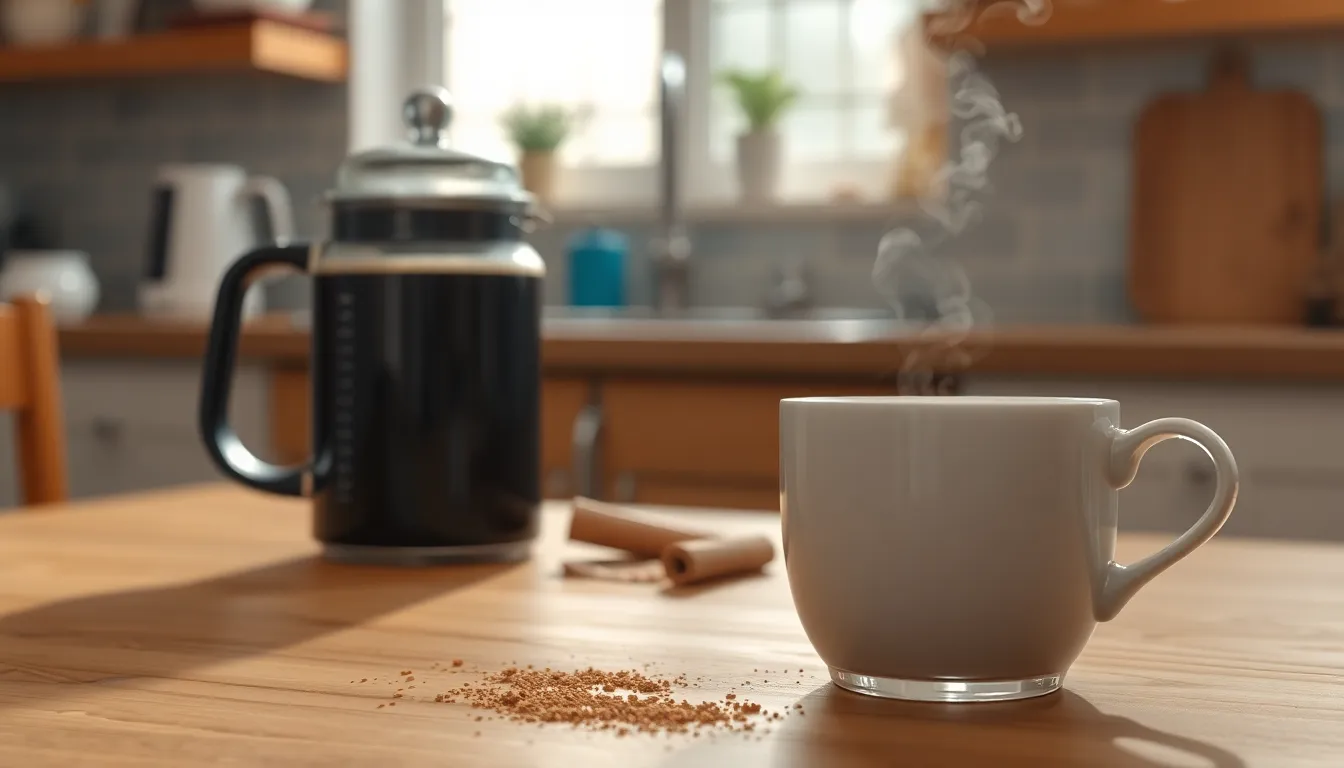Ever wondered how to make coffee with coffee creamer when you’re out of milk? You’re not alone. This simple pantry staple can transform your morning brew from basic to deliciously creamy in seconds.
Whether you’re dealing with a milk shortage or simply prefer the taste of coffee creamer, there’s a right way to incorporate it into your coffee routine. The perfect cup isn’t just about dumping creamer into hot coffee—it’s about understanding proportions, temperature, and technique. In this guide, you’ll discover how to leverage coffee creamer to create café-quality beverages right in your kitchen.
What Is Coffee Creamer and Its Different Types
Coffee creamer is a dairy-free alternative specifically designed to enhance coffee’s flavor and texture. It’s available in various formulations that dissolve easily in hot beverages, creating a smooth, creamy consistency without the need for refrigeration like traditional milk products.
Powdered vs. Liquid Creamers
Powdered creamers offer exceptional convenience with their long shelf life and no refrigeration requirements. These shelf-stable products typically contain ingredients like corn syrup solids, vegetable oils, and sodium caseinate. Powdered options blend best when added to hot coffee first, allowing the heat to fully dissolve the granules before stirring.
Liquid creamers provide instant mixing capabilities and a smoother consistency than their powdered counterparts. They’re packaged in individual cups or larger containers and come in refrigerated and non-refrigerated varieties. Non-refrigerated liquid creamers contain stabilizers and preservatives that extend shelf life, while refrigerated versions often use more natural ingredients and must be consumed within 7-10 days after opening.
Flavored vs. Non-Flavored Options
Non-flavored creamers create a neutral, creamy base that enhances coffee without altering its fundamental taste profile. These options work perfectly for coffee purists who appreciate the bean’s natural flavors but desire added richness. Original or “classic” varieties usually contain subtle vanilla notes that complement most coffee types without overwhelming them.
Flavored creamers transform ordinary coffee into specialty-like drinks with minimal effort. Popular variations include vanilla, hazelnut, caramel, chocolate, and seasonal offerings like pumpkin spice or peppermint mocha. Some brands have expanded their flavor profiles to include bakery-inspired options such as cinnamon roll, cookies and cream, or birthday cake. “I’ve found the salted caramel creamer works wonders when I’m craving something special but don’t want to spend $5 at a coffee shop,” shares Rikki Manny, who tests many coffee variations for his home brewing experiments.
Basic Coffee and Creamer Combinations

Coffee creamer transforms an ordinary cup of coffee into a delightful beverage with minimal effort. These basic combinations serve as foundation recipes that you can customize to match your taste preferences.
The Classic Black Coffee with Creamer
A freshly brewed cup of black coffee provides the perfect bold base for adding creamer. Simply pour 1-2 tablespoons of your favorite coffee creamer into the hot coffee to instantly soften its bitterness while introducing richness and creaminess. The transformation is remarkable—harsh coffee notes mellow into a smooth, satisfying drink. Many coffee enthusiasts appreciate how creamer enhances their brew without overpowering the coffee’s natural characteristics. Store-bought creamers offer convenience, while homemade versions provide control over ingredients and flavor intensity.
Perfect Creamer-to-Coffee Ratios
Finding your ideal creamer-to-coffee ratio makes all the difference in creating your perfect cup. Start with 1 tablespoon of creamer per 6-8 ounces of coffee, then adjust according to your preference. Less creamer maintains coffee’s robust flavor profile, while more creates a creamier, sweeter experience. Homemade creamers typically have richer textures and stronger flavors, so begin with smaller amounts—about half what you’d use with commercial options. Temperature affects how creamer disperses, so add it to hot but not boiling coffee for optimal blending. Morning coffee drinkers often discover their perfect ratio changes throughout the day, with stronger coffee preferences in the morning and milkier versions in the afternoon.
Step-by-Step Guide to Making Coffee with Creamer

Transform your ordinary cup of joe into a creamy delight with these simple methods. Follow these precise steps for both hot and iced coffee preparations to achieve the perfect balance of flavor and texture.
Hot Coffee Method
Brew your favorite coffee using your preferred method such as drip, French press, or espresso. The optimal brewing temperature is 200°F (93°C) for balanced extraction and full flavor development. Pour the freshly brewed hot coffee into your cup, leaving enough room for the creamer. Add 1-2 tablespoons of your chosen coffee creamer—whether dairy or non-dairy options like Nestlé’s Coffee Mate—and adjust according to your taste preferences. Stir the mixture thoroughly until the creamer completely dissolves, creating a smooth and consistent texture throughout.
For a café-style experience, try frothing your creamer to create lattes or cappuccinos at home. Combine ½ shot of espresso with ½ cup of creamer and your preferred sweetener, then froth until foamy before pouring into your coffee. This technique creates a luxurious mouthfeel similar to professional coffee shop beverages without specialized equipment.
Iced Coffee Method
Start by preparing your coffee base—either dissolve 1 rounded teaspoon of instant coffee in ½ cup of room-temperature water or brew strong coffee and allow it to cool completely. Stir in approximately ¼ cup of flavored or plain coffee creamer, such as French vanilla, until thoroughly mixed. Add a generous amount of ice cubes to chill the drink and create that refreshing cold coffee experience. Top your creation with whipped cream or cold foam for an extra touch of indulgence and visual appeal.
Coffee creamers enhance not only the flavor but also the sweetness and texture of your coffee, making each sip smoother and more satisfying. Non-dairy options provide lactose-free alternatives with rich creaminess that mimics traditional dairy products. For an even more decadent treat, try blending your coffee with creamer for a creamy cold coffee drink—this technique works especially well when using concentrated espresso shots as your coffee base.
Creative Coffee Recipes Using Creamer

Coffee creamer transforms ordinary brews into extraordinary treats with minimal effort. These recipes elevate your coffee experience beyond basic cups, letting you create café-quality specialties right in your kitchen.
Homemade Flavored Lattes
Creating homemade lattes with coffee creamer simplifies the traditional process while maintaining rich flavor. Start by brewing strong coffee or espresso as your base. Heat milk or your preferred milk alternative in a separate container until warm but not boiling. Mix your heated milk with flavored creamer—hazelnut and vanilla work exceptionally well—using approximately 2 tablespoons of creamer per cup of milk. Pour your freshly brewed coffee into a mug, then slowly add the flavored milk mixture. The creamer infuses your latte with flavor without requiring expensive syrups or equipment. Top with whipped cream for indulgence or sprinkle cinnamon or cocoa powder for an aromatic finish. This technique provides consistent results without barista training or specialty tools.
Whipped Coffee Creamer Topping
Whipped coffee creamer creates a luxurious topping that transforms both hot and iced coffee. Combine 3 tablespoons of coffee creamer with 1 teaspoon of instant coffee and 1 teaspoon of sugar in a bowl. Whip the mixture vigorously with a hand mixer until it becomes fluffy and forms soft peaks—typically 3-4 minutes. Spoon this airy creation over your prepared coffee for an instantly elevated presentation. The contrasting textures between the whipped topping and liquid coffee create a sensory experience similar to premium coffee shop offerings. French vanilla creamer produces a classic flavor profile, while caramel or hazelnut creamers introduce more complex notes. This technique works equally well as a finishing touch for hot chocolate or chai tea.
Other Creative Uses of Coffee Creamer
Coffee creamer extends beyond basic coffee enhancement into culinary versatility. Transform ordinary iced coffee into a decadent treat by blending it with coffee creamer and brownie pieces for a Brownies and Cream Iced Coffee Shake. Create refreshing Orange Creamsicle Shakes by combining orange-flavored creamer with milk and ice—perfect for summer afternoons. Make simple two-ingredient chocolate ganache using flavored creamer and chocolate chips for an easy dessert topping. Enhance breakfast by incorporating coffee creamer into Overnight French Toast Casserole batter for subtle flavor infusion. Coffee creamer also adds richness to soups, creaminess to baked goods, and complexity to smoothies, proving its worth beyond the coffee cup. The subtle flavors complement both sweet and savory dishes without overwhelming their original taste profiles.
Health Considerations When Using Coffee Creamer

Coffee creamers enhance your morning brew but come with several health factors to consider. These popular coffee additions contain varying levels of fats, sugars, and additives that impact your overall diet and wellness.
Dairy-Free and Vegan Alternatives
Plant-based coffee creamers offer excellent options for those avoiding dairy products. Many non-dairy creamers are made from almond, soy, coconut, or oat milk, making them suitable choices for vegans and people with lactose intolerance or dairy allergies. These alternatives deliver the creamy texture you love without compromising dietary restrictions. Opting for natural or minimally processed plant-based creamers helps reduce your intake of unnecessary additives while still providing that silky coffee experience you crave.
Sugar Content and Substitutes
Coffee creamers typically contain added sugars that enhance flavor but add calories to your cup. Monitoring your creamer portions prevents excess sugar consumption, as even small amounts contribute important sweetness. Sugar-free or low-sugar versions provide creaminess with fewer calories, addressing health concerns without sacrificing taste. Natural sweeteners like stevia, monk fruit, honey, or maple syrup serve as excellent alternatives to heavily processed sugars in commercial creamers. Adjusting the amount of creamer you use and selecting unsweetened or lightly sweetened options helps manage your calorie and sugar intake while still enjoying a satisfying coffee experience.
Tips for Enhancing Your Coffee-Creamer Experience

Elevate your coffee routine with simple techniques that maximize flavor and enjoyment. These expert tips will help you create a more satisfying cup every time.
Proper Storage of Coffee Creamer
Coffee creamer longevity depends entirely on how you store it. Different types of creamers require exact storage methods to maintain freshness and flavor integrity. Dairy creamers need refrigeration on a stable, cold shelf rather than the door to prevent temperature fluctuations. Always seal containers tightly after use and never leave dairy creamers at room temperature for more than two hours. Non-dairy liquid creamers can be stored in a cool, dark pantry while unopened, but require refrigeration after opening. Powdered creamers stay fresh longest when kept in a cool, dry place in an airtight container, which prevents moisture damage and clumping. Avoid exposing any creamer type to direct sunlight or heat sources, as this causes rapid spoilage and flavor degradation.
Pairing Creamers with Different Coffee Roasts
Matching your creamer with your coffee roast creates a balanced, harmonious flavor profile. Light roasts, characterized by delicate, fruity, and floral notes, pair beautifully with subtle creamer flavors like vanilla or plain cream that won’t overpower their nuance. Medium roasts offer more flexibility due to their balanced richness, working well with a wide range of creamers including caramel, hazelnut, or cinnamon varieties. Dark roasts stand up impressively to stronger-flavored creamers such as mocha, French vanilla, or spiced options that complement their bold, smoky characteristics. Experiment with different combinations to discover your perfect pairing—try warming your creamer gently before adding it to improve blending and texture. Adding complementary spices like cinnamon or nutmeg can introduce another dimension of flavor that transforms an ordinary cup into something special. Remember to adjust creamer quantity based on coffee strength and your personal preference, starting with 1-2 tablespoons per cup.
Conclusion
Transforming your daily coffee routine with creamer opens up a industry of flavor possibilities right in your kitchen. Whether you’re using powdered or liquid varieties non-dairy alternatives or indulgent flavored options you now have the knowledge to create delicious café-quality drinks at home.
Remember that the perfect cup is personal. Experiment with different ratios adjust to your taste preferences and don’t be afraid to try creative recipes beyond basic combinations. Your morning brew can be as simple or sophisticated as you desire.
By balancing flavor with health considerations and proper storage techniques you’ll maximize both enjoyment and value from your coffee creamer. Now it’s time to put these tips into practice and elevate your coffee experience one creamy cup at a time.
Frequently Asked Questions
Can I use coffee creamer instead of milk in coffee?
Yes, coffee creamer is an excellent substitute for milk in coffee. It enhances flavor and adds creaminess, often with more intensity than regular milk. Both powdered and liquid creamers work well, with powdered being more shelf-stable and liquid offering smoother blending. Start with 1-2 tablespoons per 6-8 ounces of coffee and adjust to taste.
What’s the difference between powdered and liquid coffee creamer?
Powdered coffee creamer is shelf-stable, convenient for storage, and typically lasts longer than liquid varieties. Liquid creamer blends more smoothly into coffee without clumping and often provides a richer mouthfeel. Powdered options are better for travel or offices, while liquid creamers are ideal for home use when immediate mixing and creamier texture are desired.
How much coffee creamer should I add to my coffee?
Start with 1 tablespoon of creamer per 6-8 ounces of coffee as a baseline. Adjust according to your preference for richness and flavor intensity. Morning coffees might benefit from more creamer for a smoother start, while afternoon cups might need less. The temperature of your coffee also affects blending, with hotter coffee incorporating creamer more effectively.
Are there any dairy-free coffee creamer options?
Yes, there are numerous dairy-free coffee creamers available made from plant-based ingredients like almond, soy, coconut, and oat milk. These alternatives provide similar creaminess and flavor enhancement without dairy, making them suitable for vegans, those with lactose intolerance, or milk allergies. Many come in both unflavored and flavored varieties to suit different preferences.
Can coffee creamer be used in iced coffee?
Absolutely! Coffee creamer works wonderfully in iced coffee. For best results, brew coffee at double strength and cool it completely. Add 1-2 tablespoons of creamer, stir well, then pour over ice. Liquid creamers typically blend better in cold coffee than powdered varieties. You can top with whipped cream or additional flavored creamer for extra indulgence.
How do I make a homemade flavored latte with coffee creamer?
To make a homemade flavored latte, brew strong coffee or espresso, then add 2-3 tablespoons of your favorite flavored creamer. For a frothy texture, warm the creamer separately and froth it using a handheld frother, french press, or by shaking it in a sealed jar. Pour the frothed creamer over your coffee and top with a sprinkle of cinnamon or cocoa powder.
Does coffee creamer contain a lot of sugar?
Many traditional coffee creamers contain significant amounts of sugar, with flavored varieties typically having more than unflavored options. A single tablespoon can contain 5-7 grams of sugar. However, there are numerous sugar-free and reduced-sugar alternatives available that use sugar substitutes like stevia, monk fruit, or artificial sweeteners for those monitoring their sugar intake.
How should I store coffee creamer for maximum freshness?
Liquid creamers should be refrigerated and used by their expiration date, typically within 1-2 weeks after opening. Powdered creamers should be stored in a cool, dry place with the container tightly sealed to prevent moisture. For both types, avoid contamination by using clean utensils. Some liquid creamers in shelf-stable packaging don’t require refrigeration until opened.
What coffee roasts pair best with different creamers?
Light roasts pair well with subtle, vanilla, or fruity creamers that won’t overpower their delicate flavors. Medium roasts are versatile and work with most creamer flavors, from caramel to hazelnut. Dark roasts complement rich, bold creamers like chocolate, mocha, or spiced varieties. Non-flavored creamers work well with any roast when you want to smooth the coffee without altering its flavor profile.
Can coffee creamer be used in recipes other than coffee?
Yes, coffee creamer is surprisingly versatile in the kitchen. Use it to add richness to hot chocolate, tea, or chai. It can enhance oatmeal, pancake batter, and French toast. Creamer also works well in creamy soups, sauces, and desserts like puddings or ice cream. Flavored creamers can add unique notes to baked goods without additional sugar or extracts.

